
Sweating Treatment Page Menu: 1 2 3 4 5 Next>>
Sweating Humoral Treatment in the Golden Age of Piracy, Page 4
Healing By Artificial Sweat - Sweat-Inducing Medicines
A wide variety of medicines were given credit for inducing sweat in patients, although different pharmacopoeia writers had different views of the place of these medicines in the scheme of things.
Physician Robert James has much to say abbout the general qualities and actions of
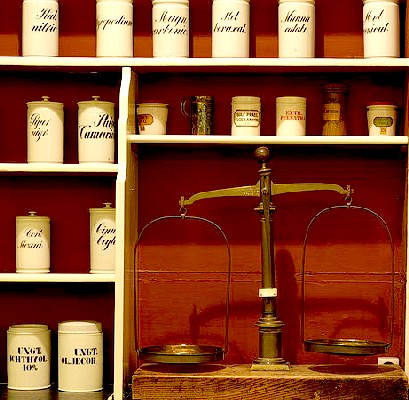
such medicines in his pharmacopoeia, always capitalizing their names ('Diaphoretics' and 'Sudorifics'), but he stops short of putting them into their own category, rather classing them as Alexipharmics (medicines to prevent poisoning).1 He seems to simply view the promotion of sweat as being a quality that Alexipharmics had.
Apothecary John Quincy takes the opposite view, classing all such medicines as 'Diaphoreticks'. He explains, "Under this Name of Diaphorteticks are included what also are understood by Alexipharmicks and Febrifuges [medicines to prevent fevers]; because all under those Denominations, whose Operations we have any notice of, exert themselves that way, by more or less encreasing a Diaphoresis; which is a Discharge by the Skin that is sensible, and shows it self like a Dew upon it."2
Quincy notes that many diaphoretics are simple medicines (those not combined with other medicines or chemically altered in any way). He first talks about cephalic medicines (those which affect the head) which "divide up and attenuate the Humours to such a a degree, that they become fine enough to escape through such small Passages, as those of the cutaneous Glands"3. He contrasts these with Aromatic medicines which 'act as soon as they come into the stomach'. Quincy explains that aromatics, "by the Volatility of their Parts divide and thin the Juices in the Primæ Viæ [bowels], but go off in a great measure by some of the larger Discharges [urine and stool]"4. He goes to say that medicines that are "Diaphoretick, are such as are capable of being divided into very small and fine Parts, which do not sensibly operate until they are brought into the minutest Vessels, where their Smallness and Activity fit them both to pass themselves, and besides make way for many others to go off with them."5
Quincy then explains that other diaphoretics are "most extensive and efficacious,
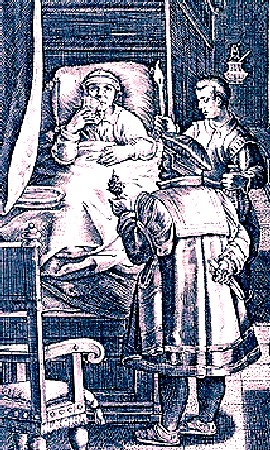
Patient Taking Medicine for the Pox, From Hyacum et
Lues Venera, By Jan van der Straet (late 16th c.)
and that is [they operate] by squeezing and contracting the Fibres, and so forcing thro what is in readiness to pass; which is a great deal in the Capillaries, or just at the Surface, that almost stagnates for want of such shocks."6 He notes that all acids work this way. "Thus we shall see People presently sweat upon eating Vinegar or Lemon-Juice."7 He equates medicines that operate this way to the sweat which is caused by "Fear, or any sudden Passion" as well as "all kinds of Exercise."8
Although the idea of this division between types of sweat-inducing medicines (and activities) may seem odd, it is repeated by several other authors. Physician John Crawford says that by using sudorifics (which he also calls hydrogogues) and diaphoretics both cause sweating and "differ only in degree of action"9. Physician Robert James provides more information, explaining that "Diaphoretics are inferior in their Power of acting as Sudorifics, but much superior to them in their healthful Qualities, as they gently increase and promote Perspiration."10
This split between a gentle and a vigorous sweat is also suggested by the authors who identify a 'breathing sweat' as being a gentler and more natural sweat. Sea surgeon John Moyle recommends raising breathing sweats for patients with dislocated or broken ribs11, where a labored sweat which would be accompanied by heavy breathing would be painful. He elsewhere explains that such a sweat "is very wholsome"12.
James expands upon this idea, noting that Sudorific and Alexipharmic medicines "excite a violent Heat and Motion and,
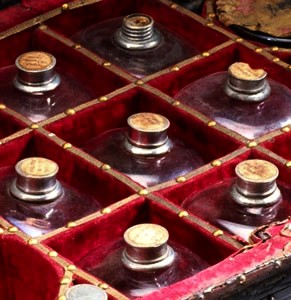
Bottles in the Vincenzo Giustiniani Medicine Chest,
From
the Wellcome Collection (1562-1566)
a considerable Orgasmi [excitement] in the Body, which tend to extort profuse Sweats, and do a great deal of Violence in Nature". He says that this results in the blood being deprived of beneficial fluids which would "otherwise be highly beneficial in preserve the whole Mass... promoting the Dissolution of the stagnant and obstructing Humours, and assisting the Expulsion of the morbific [disease-causing] Matter"13.
In contrast, James explains that diaphoretics have a "gently stimulating and perhaps resolvent [dissipating] Quality, by which they assist Nature in carrying on her own salutatory Purpose, without any Tendency to do her any Violence or divert her from the Method she has begun to pursue"14. Here again, the method viewed as being more natural is said to be preferred over the artificial.
Yet, Moyle explains that the more active alexipharmic (or sudorific) medicines are important, "for without these you will scarcely stop the Gangreen, but that it will send its malignant Attoms to the Heart, and kill the Patient."15 So both types would seem to have their place.
Of course, the understanding of medicine was still in development at this time and not all medical writers recognized a difference between sudorific and diaphoretic medicines. In his pharmacopoeia, George Bates lists several medicines as being "Diaphoretick and Sudorifick", suggesting the words meant the same thing in his text.16
1 See Robert James, Pharmacopœia universalis, pp. 163-7; 2,3,4 John Quincy, Pharmacopoeia Officinalis & Extemporanea, p. 161; 5 Quincy, p. 161-2; 6,7,8 Quincy, p. 162; 9 John Crawford, Cursus Medicinae or a Complete Theory of Physic, 1724, p. 368; 10 James, p. 165; 11 John Moyle, The Sea Chirurgeon, 1693, p. 103; 12 Moyle, p. 113; 13 James, p. 166-7; 14 James, p. 167; 15 Moyle, p. 93-4; 16 For examples, see George Bates, Pharmacopœia Bateana, edited by William Salmon, 1713, p. 49, 287, 353 & 441
Healing By Artificial Sweat - Surgeon Recommended Medicines
A variety of medicines were given credit for inducing sweat in patients, resulting in different authors recommending different medicines. This section focuses primarily on medicines which were credited as sudorifics and diaphoretics by more than one of the authors under study.
Before looking into these medicines, it is worth noting that many of them were ascribed other medicinal attributes. Since the focus of this article is on sweating, these aspects will not be discussed in any detail here. For those who are curious about the larger uses of the medicines, their entries in the Sea Surgeon's Dispensatory article on this website will be linked to when the medicine's name first appears here.

Artist: Unknown, after Egbert van Heemskerck
Removing a Plaster From the Back of a Man's Hand. Wellcome Collection (17th c.)
We begin with two externally applied medicines for sweating which were recommended by sea surgeon John Woodall. The first is a plaster called Oxicroceum which Woodall explains "by that attracting vertue it hath, it draweth out vapors (per poros cutis) of the sweate vents in the skin, whereby it often unladeth the body of vicious and noysome [disagreeable] humors which otherwise might indanger the Patient"1.
Woodall's second suggested topical diaphoretic is found in a salt bath containing "Common sea salt, boyled in the strongest beere to the consumption of three parts of the same beere and being made salt as Brine"2. Woodall advises its use in a variety of diseases including the gout and skin eruptions, noting that a patient should use a bath of it "as warme as they can possible indure it, sit in it and sweat therein, and after go to a warm bed and sweat againe, and doing so sundry times, they shall feele helpe thereby."3
Absinthe had a minor place among the sweating agents. French military surgeon Ambroise Paré includes it among the herbs he suggests be used to create the vapor and help invoke a sweat in his tub sauna.4 Woodall recommends adding salt of absinthe to water "to which for to amend the taste, you may adde sugar a little" to cause sweating. He goes to advise, "It is good and fit to adde a few graines thereof into every cordiall, for it is Diaphoreticke"5.
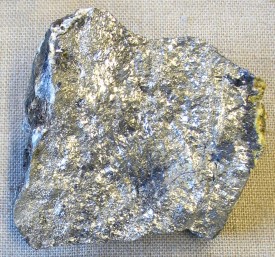
Photo: Aram Dulyan - Antimony
Antimony or Stibium was recommended by several authors. Woodall says that "it purgeth upward [causes vomiting] and downeward [is a laxative] forcibly, and causeth sweat, it is a good medicine given with carefull respect". However, he warns not to give too much because "it killeth many by the violence thereof unadvisedly administred"6. Physician John Pechey notes that it "is used in sudorific Decoctions, when we would dissipate a Tumour by Transpiration [sweating]"7.
Antimony was also heated and combined with potassium nitrate to form diaphoretic antimony, which causes sweating as its name suggests. Pechey explains that this combination 'fixes' the antimony, hindering the 'sulphurs' "from working otherwise than by sweat. This Preparation is esteemed good to procure sweat, and to resist Poyson, and consequently is good in malignant Fevers, the-Small-pox, the Plague, and other contagious Diseases."8 Sea surgeon John Moyle also points to it as an excellent sweating medicine.9
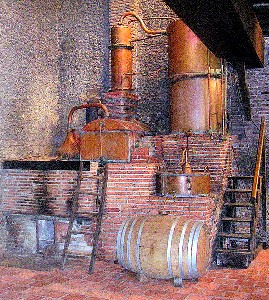
Photo: Wiki User Jibi44
French Still for Making Brandy dating to 1804
Brandy or spirit of wine or 'burnt wine' (as John Moyle refers to it) was frequently employed as a to procure perspiration. Physician Joannes Sintelaer gave it a splendid reputation in his book on the pox: "The first then and most effectual Way to raise the Sweat in this as well as some other Diseases is perform’d by Means of the Spirit of Wine highly rectify'd"10. (Rectification here refers to purification by repeated distilling.)
Moyle uses it to treat a variety of health problems that he felt required sweating, often combining it with other herbs. He uses it in catarrhs (running of the nose and throat)11, cricks in the neck12, problems with the throat13, calentures and continuous fevers14, 'new' colds15 and gangrene. (In treating gangrene, he actually uses Aqua Epidemica which contains brandy combined with a variety of herbs).16
Woodall recommends the use of blessed thistle (referred to by names that are variations on carduus benedictus) both in its raw form17 and as a water18 because he says it "moveth sweat." Physician Thomas Sydenham also found the water of blessed thistle useful as a sudorific, making it part of juleps which he created for treating pestilential fevers19 and 'inveterate Eruptions of the Skin'.20
Woodall noted that China roots "prevaile much in the cure of Lues verenea [pox], and are good for the giddinesse of the head, taketh away the paine of the stomacke, & obstructions, and are profitable for the dropsie, chollike, and gripings of the belly, moveth urine, causeth sweat, and are helpful against convulsions, the palsi and paines of the joints, and a singular remedie against a consumption."21 Joannes Sintelaer combined China roots with two other notable sweating medicines - guaiacum and sassafras - in the treatment of the pox.22
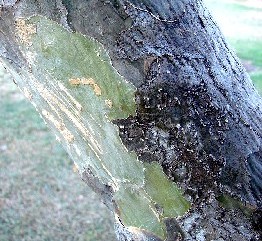
Photo: Forest & Kim Starr - Guaiacum Bark
Guaiacum bark was widely recognized as a sweating medicine. Sintelaer said that "Guajacum or Lignum Santium leads the Van[guard], its Wood, Bark, and Gum, consisting altogether of such Unctuous and Volatile Particles, as are altogether adapted by Nature, to reduce the Stubborn Acid Venereal Ferment to a better Temper"23. Moyle referred to it as one of the "best of Diaphoretiques, in the World"24 and Woodall noted that it "move[s] sweat"25. Ambroise Paré said a decoction of guaiacum was 'very fit' in treating a palsy, "for it procures sweat and attenuates, digests and drieth up all the humidity which relaxeth the nerves"26.
Paré also suggests mercury (calling it argentum vivum) as the best cure for the pox, "drying by the subtiltie of the parts and provoking sweat"27. Thomas Sydenham also implied that mercury caused a sweat since it was an alexipharmic (remedy for poison) .28
Perhaps the king of sweating medicines was opium. John Pechey pronounced, "There are but few true sudorific Medicines; and among these Opium is the chief; for the reason why Treacle or
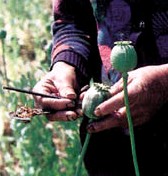
Photo: CIA
Harvesting Opium
Mithridate [compound medicines discussed in the next paragraph] cause sweat, is wholly from the Opium that is mixed with them; For these two Electuaries prepared without Opium do not provoke Sweat at all."29 Physician Gideon Harvey agreed, noting that "Opiates do effectually suppress all manner of Evacuations, except Sweating, which they promote"30.
As Pechey said, opium was often given in as a part of other compound medicines where it produced sweating. One of these was mithridate, a compound medicine that could contain over 60 other elements in its makeup. Sea surgeon Moyle called this one of the best diaphoretics in the world31 and suggested if he had it and diaphoretic antimony, he didn't require any other diaphoretic medicines in his medicine chest.32
Another compound sudorific containing opium was theriac, a medicine about which the revered ancient physician Galen spent an entire book extolling its virtues.33 Moyle said "If you
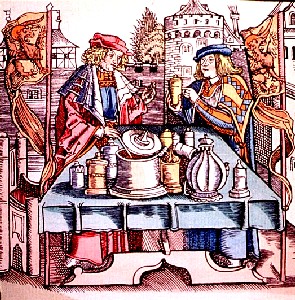
Apothecaries Making Theriac in Stuttgart (middle ages)
would sweat a man, you offer him Thriac. andromic. [Theriaca Andromachi or Venice Treacle]"33. He went on to say, "If you are provided with a considerable jarr of Thriac. Androm. and another competent Bottle of Aq. Thriac. [Treacle water - containing a variety of medicines which include Venice Treacle, Mithridate and Carduus Benedictus] and a sufficient Mass of Matthews's Pill [a compound medicine containing opium, hellebore, and licorice mixed with ol. Terebinth and Salt of Tartar]; then you may judge your self very well provided as to Sudorificks (and they are certainly as good as any in the World)."34 Moyle also recommended London Treacle which he advised worked as well as other sudorific medicines and "may be used in all Diseases wherein Sweating is required"35. Ambroise Paré also advised its use, explaining that treacle water was good for treating the plague. "For
by sweat it drive's forth the poison contained within."36
Posset drinks were also credited with sweating qualities. Posset drinks were cream-based, often containing sugar, ale or wine and other flavor enhancers such as cinnamon or ginger and rose-water. Dr. Sydenham used posset drinks to raise a sweat for patients with tertian agues37 ( malarial fevers the recur every 48 hours). He also ordered posset drink for pestilential fevers such as accompanied bubonic plague and typhus, explaining that it was to be served "somewhat hot, and that the use of Sage Posset-drink be continued twenty four hours after the Sweat"38. Although Sydenham's preference for sage posset is notable, the most potent ingredient for sweating was probably the warm 'ale or wine'. John Moyle likewise recommended this in calentures and continual fevers39 and as a part of the cure for the pox.40 He advised surgeons to give the patient "warm Posset-drink, and let him Sweat well, having a warm Cloth in the Bed with him to wipe off the Sweat withal."41
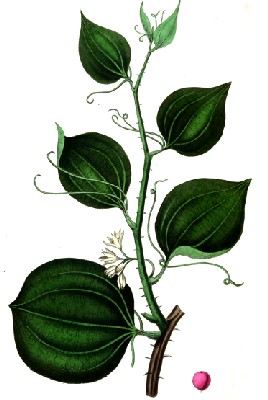
Sarsaparilla Smilax, From Medicinal Plants of the
London,
Edinburgh and Dublin Pharmacopoeias, Vol. 3 (1837)
Woodall said that sarsaparilla "causeth sweat, especially extinguisheth the heat of venereous poyson, and is good for the articular diseases [diseases of the joints such as arthritis], ulcers, and phlegmaticke humours, and principally it is good against the french pox."42 Sydenham implied it caused sweating in pestilential fevers which helped to eject the poison he thought to be the cause of the fever.43 Sintelaer also used sarsaparilla in some of the compound medicines he prescribed to treat the pox.44
Sintelaer gave high praise to sassafras, explaining that its wood was "a more powerful Remedy against the foul Disease [the pox] than the Guajacum it self, by reason of its Aromatick oleagenous [oily] Parts wherewith it abounds (as is evident from its strong odoriferous Scent) which may therefore be look'd upon as a peculiar Anti-venereal Specifick"45. However, he warned that it was 'excessive Hot and Dry' (referring to its humoral qualities) and should be "qualify'd with the addition of some Roots and other Ingredients", which included China root and sarsaparilla.46
Woodall enthused that sassafras water was useful in a wide variety of diseases which included scurvy and the pox "for it provoketh urine and sweat, in a very milde and naturall manner, and driveth out many diseases by the poores of the skinne"47.
Sulfuric acid (spirit of vitriol) was recommended as a sudorific medicine by both sea surgeons John Moyle48 and John Woodall49. Moyle used various types of vitriol to assist in sweating in scurvy50, surfeits [problems caused by eating or drinking too much]51 and continuous and tropical fevers (calentures).52
These dozen medicines (and medicines made from them) make up the majority of the 'drugs' used by the surgeons at this time to encourage sweating. This is certainly not a complete list of such medicines, although it includes some of the most important and recommended ones from the time according to the authors under study.
1 John Woodall, the surgions mate, 1617, p. 42; 2 Woodall, p. 275; 3 Woodall, p. 275-6; 4 Ambroise Paré, The Workes of that Famous Chirurgion Ambrose Parey, 1649, p. 260; 5 Woodall, p. 276; 6 Woodall, p. 111; 7,8 John Pechey, A Plain Introduction to the Art of Physick, 1697, p. 233; 9 John Moyle, The Sea Chirurgeon, 1693, p. 5-6; 10 Joannes Sintalaer, The Scourge of Venus and Mercury, 2nd ed,, 1709, p. 230; 11 John Moyle, Abstractum Chirurgæ Marinæ, 1686, p. 114, 12 Moyle, Abstractum, p. 100; 13 Moyle, Chirurgeon, p. 238; 14 Moyle, Chirurgeon, p. 157; 15 Moyle, Abstractum, p. 113; 16 Moyle, Chirurgeon, p. 93; 17 Woodall, p. 120; 18 Woodall, p. 58 (erroneously shown as 44); 19 Thomas Sydenham, The Whole Works of Dr. Thomas Sydenham, 3rd ed, 1701, p. 73; 20 Sydenham, p. 208; 21 Woodall, p. 97; 22,23 Sintalaer, p. 236; 24 Moyle, Abstractum, p. 4; 25 Woodall, p. 98; 26 Paré, p. 260; 27 Paré, p. 473; 28 Sydenham, p. 64; 29 Pechey, p. 166; 30 Gideon Harvey, The Vanities of Philosophy and Physic, 2nd ed, 1700, p. 72; 31 Moyle, Abstractum, p. 4; 32 Moyle, Chirurgeon, p. 6; 33 Kate Kelley, Early Civilizations: Prehistoric Times to 500 C.E., 2009, p. 132; 33 Moyle, Chirurgeon, p. 5; 34 Moyle, Chirurgeon, p. 6; 35 Moyle, Abstractum, p. 4; 36 Paré, p. 540; 37 Sydenham, p. 46; 38 Sydenham, p. 75; 39 Moyle, Chirurgeon, p. 159; 40 Moyle, Chirurgeon, p. 144; 41 Moyle, Chirurgeon, p. 159; 42 Woodall, p. 97-8; 43 Sydenham, p. 64; 44 Sintalaer, p. 243-4; 45 Sintalaer, p. 235-6; 46 Sintalaer, p. 236; 47 Woodall, p. 56; 48 Moyle, Abstractum, p. 99-100; 49 Woodall, p. 280; 50 Moyle, Abstractum, p. 99; 51 Moyle, Abstractum, p. 107; 52 Moyle, Chirurgeon, p. 159;
Healing By Artificial Sweat - Dangers of Medication
While some physicians and several surgeons promoted sweat by medicines, others warned of their use, particularly in certain cases.
Given his belief that natural sweating was the best way to purge the body of corrupted humors, it should not be surprising
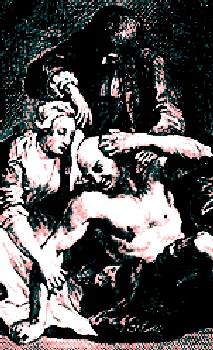
Artist: William Hogarth
From A Rake's Progress, Plate 8 (1735)
that one of those generally opposed to artificial sweating in certain cases was physician Thomas Sydenham. When discussing the treatment of intermittent fevers (such as malarial or other tropical fevers), he warned that sweat could not "be provoked without great danger to the Sick, who was presently precipitated [prematurely brought] into a Frenzie, and other dangerous Symptoms, by forcing Sweat."1 Curiously, he appears to have changed his mind on this point; in an account in his book from an earlier period, he had advised the use of posset drinks in tertian agues.2
In continual fevers (long-lasting fevers that occur in pneumonia and some influenzas), Sydenham said that tacit delirium ("a Stupor like a Coma") was "most commonly occasioned by the over-officiousness of Nurses provoking Sweat [by artificial means]; for by this means the morbifick [disease-causing] Matter, which refuses to yield in this kind of Fever to sweats, is violently exagitated [stirred up], and at length elevated to the head, to the great hazard of the Sick."3 He later warns that "when the Fever has possessed the Head, and the Phrensie has once prevailed, then no signs of the Fever remain, only the Pulse is sometimes quicker, sometimes slower. But at length, when by ill management, the spirits are driven into a Confusion, the Pulse is inordinate [excessive], with a Subsultus of the Members [twitching of the limbs], and Death soon follows."4
Naval physician William Cockburn is generally opposed to resorting to sudorific and diaphoretic medicines for some fevers. For example, in fevers that occur with colds, he says, "I cannot forbear observing that an Untimely use of Sweating Medicines in some, and thickning Lozenges in others is more frequently the productive cause of Fevers, Phthisicks [wasting illness of the lungs], &c. and of more fatal consequence than a Cold could have been, if left to the strength of the blood and abstinence, without employing any other Auxiliaries"5.
However, most of the physicians and surgeons under study seem to have used them, albeit in sometimes cautious fashion.
1 Thomas Sydenham, The Whole Works of Dr. Thomas Sydenham, 3rd ed, 1701, p. 183; 2 Sydenham, p. 46; 3 Sydenham, p. 160; 4 Sydenham, p. 416; 5 William Cockburn, An Account of The Nature, Causes, Symptoms and Cure of the Distempers That are incident to Seafaring People, 1696, p. 27

